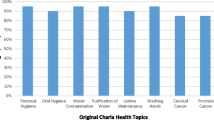Abstract
Understanding key health concepts is crucial to participation in Precision Medicine initiatives. In order to assess methods to develop and disseminate a curriculum to educate community members in Northern Manhattan about Precision Medicine, clients from a local community-based organization were interviewed during 2014–2015. Health literacy, acculturation, use of Internet, email, and text messaging, and health information sources were assessed. Associations between age and outcomes were evaluated; multivariable analysis used to examine the relationship between participant characteristics and sources of health information. Of 497 interviewed, 29.4 % had inadequate health literacy and 53.6 % had access to the Internet, 43.9 % to email, and 45.3 % to text messaging. Having adequate health literacy was associated with seeking information from a healthcare professional (OR 2.59, 95 % CI 1.54–4.35) and from the Internet (OR 3.15, 95 % CI 1.97–5.04); having ≤ grade school education (OR 2.61, 95 % CI 1.32–5.17) also preferred information from their provider; persons >45 years (OR 0.29, 95 % CI 0.18–0.47) were less likely to use the Internet for health information and preferred printed media (OR 1.64, 95 % CI 1.07–2.50). Overall, electronic communication channel use was low and varied significantly by age with those ≤45 years more likely to utilize electronic channels. Preferred sources of health information also varied by age as well as by health literacy and educational level. This study demonstrates that to effectively communicate key Precision Medicine concepts, curriculum development for Latino community members of Northern Manhattan will require attention to health literacy, language preference and acculturation and incorporate more traditional communication channels for older community members.
Similar content being viewed by others
References
Kelley, M. S., Su, D., & Britigan, D. H. (2016). Disparities in health information access: Results of a county-wide survey and implications for health communication. Health Communication, 31(5), 575–582.
Institute of Medicine. (2004). Health literacy: A prescription to end confusion. Washington, DC: Institute of Medicine.
Collins, F. S., & Varmus, H. (2015). A new initiative on precision medicine. New England Journal of Medicine, 372(9), 793–795.
Transcript of obama’s 2016 state of the union address. (2016). New York Times. Retrieved January 12, 2016, from http://www.nytimes.com/2016/01/13/us/politics/obama-2016-sotu-transcript.html?_r=0.
Budin-Ljosne, I., & Harris, J. R. (2015). Ask not what personalized medicine can do for you–ask what you can do for personalized medicine. Public Health Genomics, 18(3), 131–138.
Giuse, N.B., Kusnoor, S.V., Koonce, T.Y., et al. (2016). Guiding oncology patients through the maze of precision medicine. Journal of Health Communication, 21(Suppl 1), 5–17.
Kaphingst, K.A., Blanchard, M., Milam, L., Pokharel, M., Elrick, A. & Goodman, M.S. (2016). Relationships between health literacy and genomics-related knowledge, self-efficacy, perceived importance, and communication in a medically underserved population. Journal of Health Communication, 21(Suppl 1), 58–68.
Paasche-Orlow, M. K., & Wolf, M. S. (2010). Promoting health literacy research to reduce health disparities. Journal of Health Communication, 15(Suppl 2), 34–41.
Institute of Medicine Roundtable on Health Literacy. (2011). The role of health literacy in health disparities research. Innovations in health literacy research: Workshop summary. Washington, DC: National Academies Press (US).
Rodriguez, S. A., Roter, D. L., Castillo-Salgado, C., Hooker, G. W., & Erby, L. H. (2015). Translation and validation of a Spanish-language genetic health literacy screening tool. Health Psychology, 34(2), 120–129.
Washington heights neighborhood in New York, New York, 10032, 10033, 10040 detailed profile. (2011). Urban Mapping. http://www.city-data.com/neighborhood/Washington-Heights-New-York-NY.html.
Morris, N. S., MacLean, C. D., Chew, L. D., & Littenberg, B. (2006). The single item literacy screener: Evaluation of a brief instrument to identify limited reading ability. BMC Family Practice, 7, 21.
Marin, G., & Gamba, R. J. (1996). A new measurement of acculturation for Hispanics: The bidimensional acculturation scale for Hispanics (BAS). Hispanic Journal of Behavioral Science, 18, 297–316.
National Cancer Institute. (2010). Health information national trends survey (HINTS) trends in cancer information seeking. http://hints.cancer.gov/briefsDetails.aspx?ID=235.
National Cancer Institute. (2014). Health Information National Trends Survey (HINTS), HINTS 4 Cycle 4. 2014. http://hints.cancer.gov/.
Selsky, C., Luta, G., Noone, A.M., Huerta, E.E. & Mandelblatt, J.S. (2013). Internet access and online cancer information seeking among Latino immigrants from safety net clinics. Journal of Health Communication, 18(1), 58–70.
Laz, T. H., & Berenson, A. B. (2013). Racial and ethnic disparities in internet use for seeking health information among young women. Journal of Health Communication, 18(2), 250–260.
Cutilli, C.C. (2010). Seeking health information: what sources do your patients use? Orthopaedic. Nursing, 29(3), 214–219.
Weaver, J. B., Mays, D., Weaver, S. S., Hopkins, G. L., Eroğlu, D., & Bernhardt, J. M. (2010). Health information–seeking behaviors, health indicators, and health risks. American Journal of Public Health, 100(8), 1520–1525.
Dutta-Bergman, M. J. (2005). Developing a profile of consumer intention to seek out additional information beyond a doctor: The role of communicative and motivation variables. Health Communication, 17(1), 1–16.
Clarke, M.A., Moore, J.L., Steege, L.M., et al. (2015). Health information needs, sources, and barriers of primary care patients to achieve patient-centered care: A literature review. Health Informatics Journal (Epub ahead of print).
Lee, Y.J. & Boden-Albala, B. (2014). Online health information seeking behaviors of Hispanics in New York City: A community-based cross-sectional study. Journal of Medical Internet Reseach, 16(7), e176.
Acknowledgments
KMS and MOA were supported by a National Cancer Institute grant (P30CA013696-40).
Author information
Authors and Affiliations
Corresponding author
Ethics declarations
Conflict of Interest
The authors declare that they have no conflict of interest.
Rights and permissions
About this article
Cite this article
Hillyer, G.C., Schmitt, K.M., Lizardo, M. et al. Electronic Communication Channel Use and Health Information Source Preferences Among Latinos in Northern Manhattan. J Community Health 42, 349–357 (2017). https://doi.org/10.1007/s10900-016-0261-z
Published:
Issue Date:
DOI: https://doi.org/10.1007/s10900-016-0261-z




